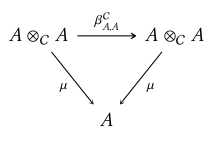Ring objects are usually defined on Cartesian monoidal categories, but one can define them more generally on non-Cartesian symmetric monoidal categories as follows:
- Let $(\mathcal{C},\otimes,\mathbf{1})$ be a symmetric monoidal category.
- When equipped with the tensor product of $\mathcal{C}$, the category $\mathsf{CCoMon}(\mathcal{C})$ of cocommutative comonoids in $\mathcal{C}$ becomes Cartesian monoidal ― note that this requires $\mathcal{C}$ to be symmetric.
- A ring object in $\mathcal{C}$ is then a ring object in $\mathsf{CCoMon}(\mathcal{C})$.
Alternatively, if
- $\mathcal{C}$ and the category $\mathsf{HopfMon}^{\mathrm{bicomm}}(\mathcal{C})$ of bicommutative Hopf monoids in $\mathcal{C}$ have all co/limits, and
- there is a "free bicommutative Hopf monoid functor" $\mathcal{C}\to\mathsf{HopfMon}^{\mathrm{bicomm}}(\mathcal{C})$,
then we can mimic the construction of tensor products of abelian groups in $\mathcal{C}$, obtaining a symmetric monoidal category $(\mathsf{Ab}(\mathcal{C}),\boxtimes)$, the monoids in which are then defined to be ring objects in $\mathcal{C}$.
Note that
- Replacing $\mathsf{HopfMon}^{\mathrm{bicomm}}(\mathcal{C})$ by $\mathsf{BiMon}^{\mathrm{bicomm}}(\mathcal{C})$ and carrying out the second approach, one obtains a notion of a rig object in $\mathcal{C}$.
- The latter approach is the one developed in Part II of Goerss's Hopf Rings, Dieudonné Modules, and $E_*\Omega^2S^3$. See there for more details and arXiv:1804.10153 for the example of Hopf algebras and affine and formal abelian group schemes.
- When both approaches can be carried out, they agree.
Examples
Examples of ring and rig objects in monoidal categories are the following.
- When $\mathcal{C}=\mathsf{Sets}$, one recovers rings and rigs, as $\mathsf{CCoMon}(\mathsf{Sets})\cong\mathsf{Sets}$, or alternatively since \begin{align*} \mathsf{HopfMon}^{\mathsf{bicomm}}(\mathsf{Sets}) &\cong \mathsf{Ab},\\ \mathsf{BiMon}^{\mathsf{bicomm}}(\mathsf{Sets}) &\cong \mathsf{CMon}, \end{align*} with $\boxtimes$ recovering the tensor product of abelian groups or commutative monoids.
- More generally, rings in Cartesian monoidal categories coincide with the usual notion of a ring object in a category with finite limits.
- Rings in $(\mathsf{Ab},\otimes_{\mathbb{Z}},\mathbb{Z})$ and $(\mathsf{Rings},\otimes_{\mathbb{Z}},\mathbb{Z})$ are plethories.
- A categorification of this approach, where one replaces monoids by pseudomonoids, recovers $2$-rigs and $2$-rings.
Background
Let $(\mathcal{C},\otimes,\mathbf{1})$ be a monoidal category. A monoid in $\mathcal{C}$ consists of an object $A$ of $\mathcal{C}$ together with maps $\mu\colon A\otimes A\to A$ and $\eta\colon\mathbf{1}\to A$ making the diagrams
commute. For example, monoids in the Cartesian monoidal category of sets recover ordinary monoids, while monoids in $(\mathsf{Ab},\otimes_{\mathbb{Z}},\mathbb{Z})$ recover (non-commutative) rings. Moreover, if $\mathcal{C}$ has a braided monoidal structure, we say that a monoid $(A,\mu,\eta)$ in $\mathcal{C}$ is commutative if the diagram
commutes. Again, this recovers commutative monoids and commutative rings when applied to $\mathsf{Sets}$ and $\mathsf{Ab}$.
Dually, a comonoid in $\mathcal{C}$ is a monoid in $\mathcal{C}^{\mathsf{op}}$: it is a triple $(C,\Delta,\epsilon)$ consisting of an object $C$ of $\mathcal{C}$ equipped with maps $\Delta\colon C\to C\otimes C$ and $\epsilon\colon C\to\mathbf{1}$ making the diagrams
commute. Cocommutative comonoids are defined dually to commutative monoids.
Any object of a Cartesian monoidal category is canonically a comonoid when equipped with the diagonal and projection to the unit maps. They are quite more interesting if the category in question is non-Cartesian, however: in $\mathsf{Mod}_{R}$, for instance, they give rise to $R$-coalgebras.
Now, we can also consider bimonoids in (a braided monoidal category) $\mathcal{C}$. These are objects of $\mathcal{C}$ equipped with both a monoid and a comonoid structure in a compatible way (image from the bialgebra page in Wikipedia):
A bimonoid in $\mathcal{C}$ is bicommutative if it is commutative and cocommutative.
A Hopf monoid in $\mathcal{C}$ is a bimonoid $H$ in $\mathcal{C}$ together with a morphism $\sigma\colon H\to H$, called the antipode of $H$, making the diagrams
commute. In a sense, Hopf monoids are bimonoids with inverses: bimonoids in $\mathsf{Sets}$ are monoids, but Hopf monoids in $\mathsf{Sets}$ are groups.
The classical examples of bimonoids and Hopf monoids are bialgebras and Hopf algebras.
The question
What are some other examples of rings and rigs in monoidal categories, in particular non-Cartesian ones?





